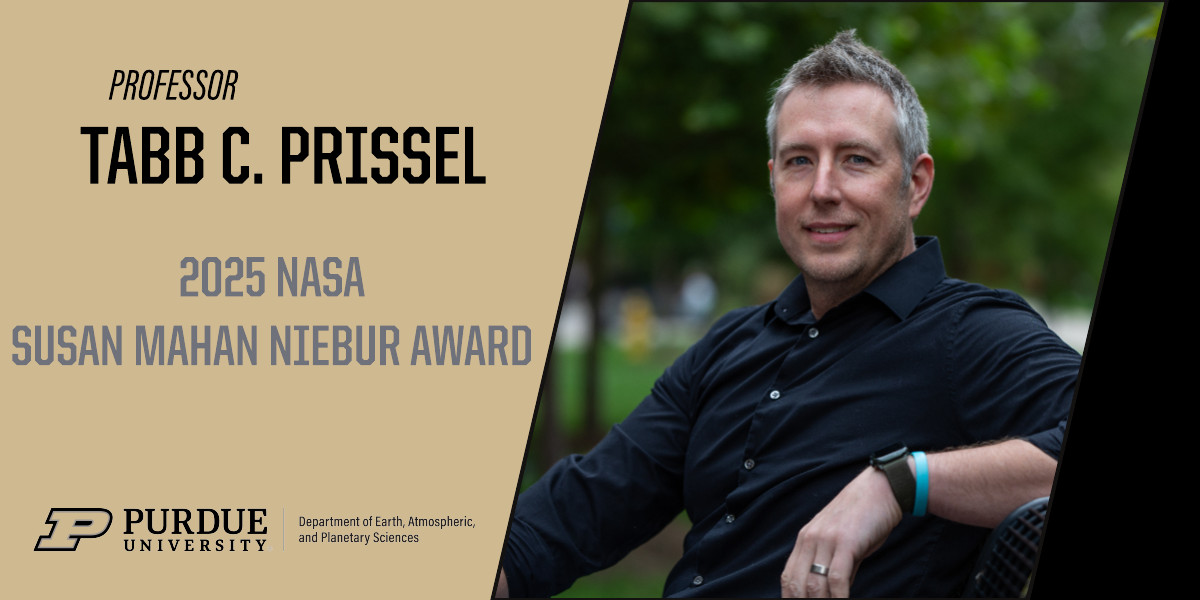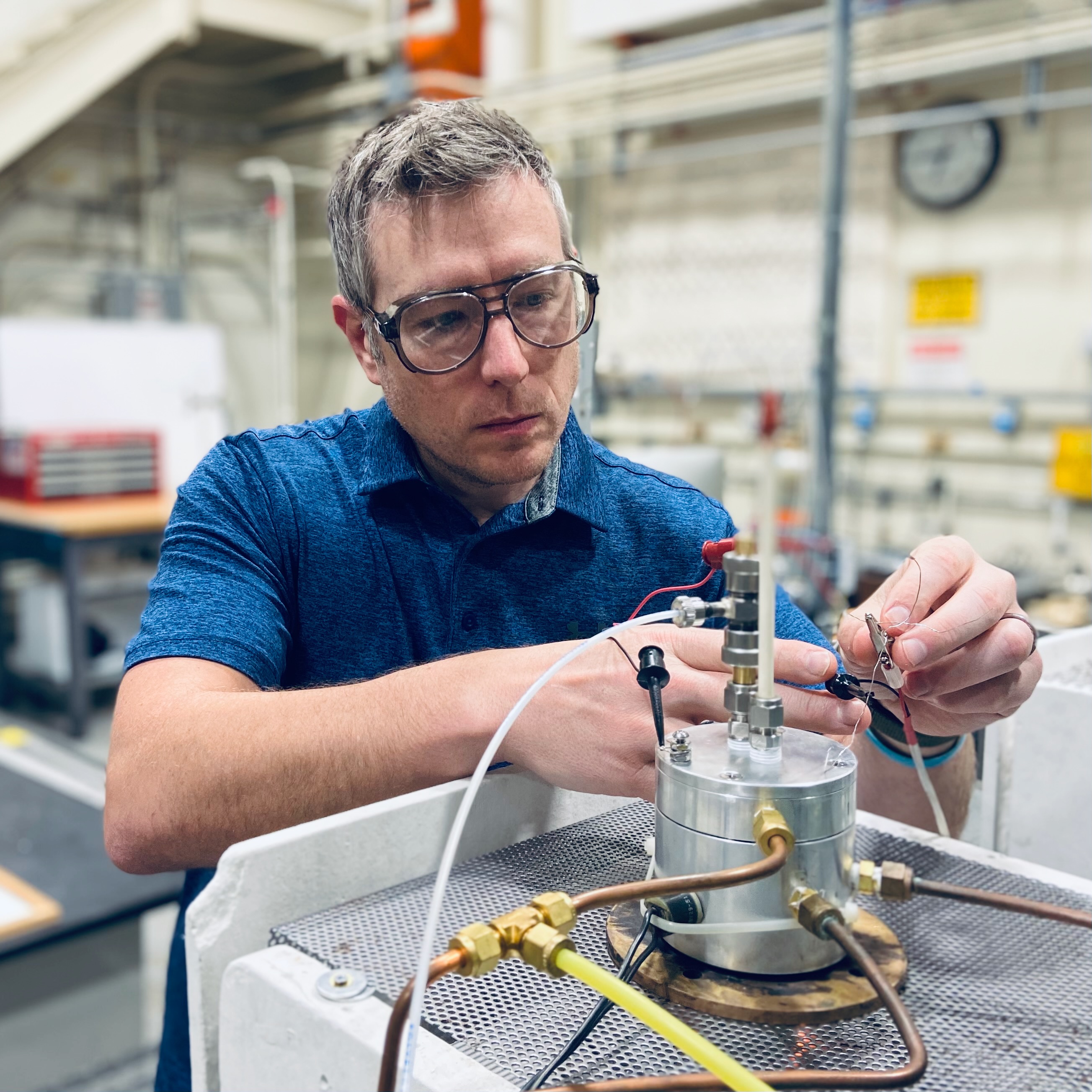Purdue EAPS Professor Tabb Prissel Honored with NASA Susan Mahan Niebur Award for Groundbreaking Planetary Research
08-18-2025

Tabb Prissel, assistant professor in Purdue University's Department of Earth, Atmospheric, and Planetary Sciences, has been named the 2025 recipient of the Susan Mahan Niebur Award. One of NASA's most prestigious honors for early career planetary scientists. The Susan Mahan Niebur award is presented annually at NASA's Exploration Science Forum to recipients within 10 years of their Ph.D. who have demonstrated excellence in their field and made significant contributions to the exploration science community.
The Susan Mahan Niebuer Award is issued by NASA's Solar System Exploration Research Virtual Institute (SSERVI), which is headquartered at the NASA Ames Research Center. SSERVI plays a critical role in advising NASA's Science Mission Directorate and Human Exploration and Operations Mission Directorate on cross-disciplinary and strategic initiatives toward advancing human exploration of the solar system through scientific discovery. Previous recipients of the Susan Mahan Niebur award have gone onto leadership roles at NASA, NASA's Artemis Campaign, and are leading missions to the Moon. The award is named in honor of Dr. Susan Niebur, who was an astrophysicist and Discovery Program Scientist for NASA.
"To have NASA, SSERVI, and the planetary science community recognize my early career contributions alongside Dr. Niebur's achievements and her advocacy for early career colleagues is an immense honor," Prissel said. "I aim to follow in the footsteps of my fellow recipients and uphold Purdue's rich legacy in lunar exploration by making our next giant leap back to the Moon through mission and instrument development."
Prissel's research focuses on unlocking the Moon's earliest volcanic and magmatic history, which is a key record of early planetary evolution that Earth has lost due to billions of years of plate tectonics and erosion. Prissel's contributions include development of a new proxy for identifying the earliest stages of volcanic activity across the Moon's surface.
Using high-temperature experiments, Prissel simulated what happens when lunar magmas interact and mix with the Moon's crust. These melt-rock reactions revealed the formation of a special type of oxide mineral called spinel that uniquely matched the geochemistry of ancient volcanic Apollo samples and orbital spacecraft observations.
Building on this discovery, Prissel led an international collaboration that integrated the chronology of Apollo samples, orbital spacecraft data, and advanced 3D geodynamic models of the Moon's interior. Prissel's research is challenging long-standing paradigms in lunar science and redefining the drivers of early volcanic activity, and his publication is now highlighted in Nature's special collection "Geology of the Moon."
For Prissel, the award comes with an additional layer of significance. When his postdoctoral position unexpectedly fell through as he was graduating with a Ph.D. from Brown University, Prissel was faced with some difficult choices.
"Perhaps the most meaningful thing to me about receiving the Susan Mahan Niebur Award is reflecting back on the persistence it took for me to stay in the field," Prissel said. "When my postdoc fell through last-minute, I had to take a job waiting tables day and night to make ends meet. I didn't know what was going to happen next but I just wasn't ready to give up on planetary science. So, I did the only thing I could, and I continued my research in the couple hours I had between shifts at a coffee shop across the street from the restaurant. It was a ton of work, but sometimes life hands you a challenge and you just have to make some tableside guacamole. In thinking about that time of my early career, I see this award recognizing my contributions to planetary and exploration science as well as the hurdles I've had to overcome and the family and friends that have been there believing in me every step of the way."
Prissel's work comes at a pivotal time for planetary science. As NASA's Artemis Campaign prepares to return astronauts to the Moon and bring back new samples for study, planetary scientists are entering what Prissel calls a "lunar sample renaissance."
"We are truly entering a new sample science era, which means that we are on the brink of advancing several outstanding issues in planetary science," Prissel said, "including the origin of the Earth-Moon system and how volatiles or dynamic impact processes have shaped our solar system."

Tabb Prissel conducting a high-temperature experiment on a synthetic basalt. (Photo Courtesy: Tabb Prissel)
Prissel conducts his work in the Purdue Petrology Suite and serves as an Instrument Scientist Lead for Purdue Resources Empowering Coordinated Investigations for Sample Exploration (PRECISE), a newly established NASA Planetary Science Enabling Facility on campus. These facilities provide state-of-the-art analytical tools for Earth, planetary, and synthetic materials research.
In addition to his research, Prissel serves as Chair of Workforce Development on the Executive Committee of the Lunar Exploration Analysis Group, supporting the next generation of planetary scientists. Prissel plans to build on his research by contributing to mission and instrument proposals for NASA programs supporting future human and robotic exploration of the Moon.
About Susan Mahan Niebur
Trained as an astrophysicist, Susan Mahan Niebur (1978-2012) was a former Discovery Program Scientist at NASA. Niebur went to NASA Headquarters straight out of graduate school as a Presidential Management Intern in what is now NASA's Science Mission Directorate. She worked at NASA Headquarters for 5 years and initiated the first ever Early Career Fellowship and the annual Early Career Workshop to help new planetary scientists break into the field. Her focus on the special challenges faced by young researchers was acknowledged in 2011 with the Public Service Award from the NASA Planetary Science Division for her "exemplary leadership abilities [that] have helped many women in the field, both planetary and astrophysics." Her research was complemented by her outreach efforts, which included a series of interviews and community-building at Women in Planetary Science. Niebur was a shining example of courage. She shared honesty and showed hope in the most difficult of predicaments. Susan's mantra was "All that survives after our death are publications and people. So, look carefully after the words you write, the thoughts and publications you create, and how you love others. For these are the only things that will remain." She will be remembered for her untiring work at bringing people together and finding ways to help everyone live up to their potential; for the passion and incredible energy she brought to everything she did; for the constant encouragement and inspiration she provided to others; and for her wonderful and unfailing smile.
About the Department of Earth, Atmospheric, and Planetary Sciences at Purdue University
The Department of Earth, Atmospheric, and Planetary Sciences (EAPS) combines four of Purdue's most interdisciplinary programs: Geology & Geophysics, Environmental Sciences, Atmospheric Sciences, and Planetary Sciences. EAPS conducts world-class research, educates undergraduate and graduate students, and provides our college, university, state and country with the information necessary to understand the world and universe around us. Our research is globally recognized, our students are highly valued by graduate schools, employers, and our alumni continue to make significant contributions in academia, industry, and federal and state government.
Written by: David Siple, communications specialist, Department of Earth, Atmospheric, and Planetary Sciences (EAPS) at Purdue University.